NMEA 2000, real world issues
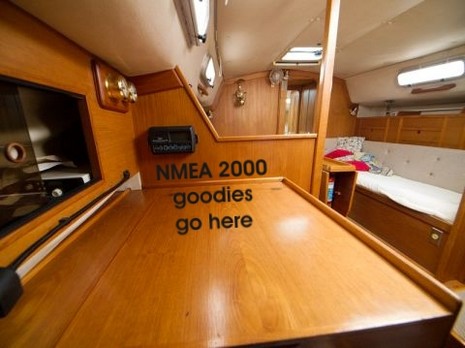
Chris Witzgall from Apex, NC, recently wrote {slightly edited}:
Your site has been invaluable as I get back into boating after a long hiatus, and work out the electronics for our new-to-us Westerly Fulmar sailboat. I have settled on NMEA 2000. Our needs are relatively simple; here is what I have**, or will have*.
** Simrad TP32 Tillerpilot (Great deal barely used of of eBay)
** Lowrance 7300c HD Chartplotter (old “Blue” N2K connector)
* Maretron Smart Triducer (depth, speed, temp in one hole)
* Simrad masthead wind transducer
* Some display for wind, depth etc.(will Simrad Mega display the Maretron depth?)My trouble is that Simrad, Maretron and Lowrance all are NMEA 2000, but with different connectors. So should I settle on a NMEA standard backbone, and convert Simrad and Lowrance to that backbone? Or something else? Can I do a hybrid, connecting all of the Simrad to a SimNet, and then connecting that backbone to the Lowrance one? Will the power over one feed the other?
I think there are a lot of ways to skin this cat. In my experience mixing NMEA 2000 cable designs, even backbones, works fine. And my personal bias is toward standard NMEA 2000 cabling with patch cables as needed. But considering what Chris already has in hand, plus the reasonable cost of the Simrad wind transducer (see link above), I’m thinking he should go all SimNet backbone with one ugly homemade patch cable from the Lowrance. Simrad’s own “smart” triducer is likely very similar to Maretron’s, probably even also made by Airmar. For instrument heads, he could go with a Combi and a Wind, or just a Graphic (plus transducers) that could do both. Mind you, I’m pretty sure the Lowrance plotter can show the depth, speed, and temp data, but will not understand the wind messages. The prices look fairly reasonable for the Simrad gear, and this system should be robust and easily added on to, but Chris is working with a tight budget. What to you think he should do? And, by the way, the guy is an amazing wedding photographer.
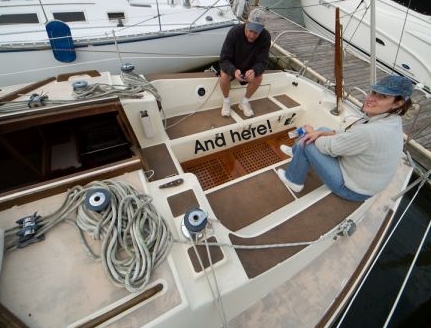



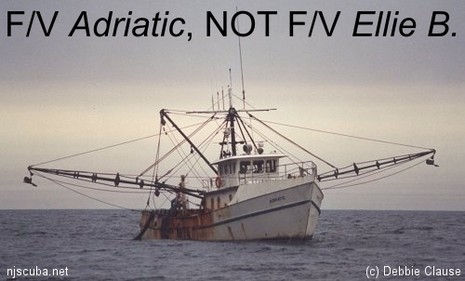
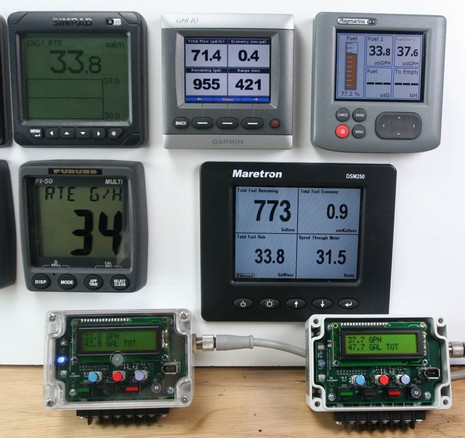
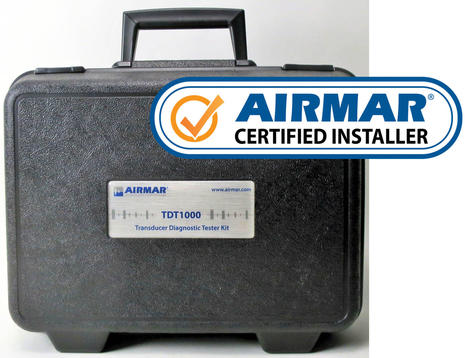







The NMEA backbone will be with your boat as long as you own it. It will (or should) outlive all of the equipment that you are currently planning to install.
I believe that the proprietary connectors will go away in the next 1-3 years. They are economically inefficient for everyone except the manufacturer of the connector (i.e., Molex) and add annoyance, but no value, for the customer.
So I believe that when you add some additional equipment 1-2 years from now (AIS?), and when you begin to upgrade this equipment 3-5 years from now (e.g., AIS enabled N2K VHF) you’ll be buying equipment with standard connectors. For that reason, I would (and am on my boat) install a generic NMEA 2000 backbone with generic NMEA 2000 drops, then insert adapters as necessary. You don’t want to have to run a new NMEA 2000 cable up your mast when the SimNet connectors are thrown on the same pile as your 8 track tapes.
As noted, I tend to agree with you, Russ, but isn’t the light, skinny SimNet cable particularly tempting for running up the mast. Note that Simrad’s IS20 wind sensor comes with 20 meters of cable (the IS12 above, 30m) and an internal terminator so it can form one end a backbone. Even if you want to go Molex from there, I think you can just use a patch cable, or cut off the SimNet connector and rig a field attachable connector.
Tempting yes, but no a good choice IMHO.
How much weight is it going to save versus a standard micro cable which can also be terminated at the masthead?
I consider this to be major infrastructure investment in the boat and thus something that should be viewed over the long term. As I mentioned, I think the SimNet connectors will look like 8 track tapes in five years.
But if Chris is confident that SimNet is here for the long term, or at least until he can successfully sell his boat, then no issue. If not, then he’ll need to carefully weigh (no pun intended) the benefits of the slightly smaller cable versus whatever other weight he could remove from his mast.
If it’s really about weight, how about TackTick?
I think TackTick would be smart to develop a NMEA 2000 interface box, especially now that all these N2K instruments have appeared.
… or how about if the lower end chartplotters targeting the same market (like those that already have built in GPS antennas) worked out a deal to license the technology and included an additional internal antenna (Bluetooth is it ?) to listen for the wireless data exchanged by the TackTick sensors, and optionally made the data appear on their N2K ports.
Interesting idea! But I don’t think it’s right to characterize TackTick as down market. I’ve seen their gear on racing boats, hard-working charter cats, etc. and it’s not cheap.
When they first came out I watched a French multi hull ocean racer’s eyes light up when he realized they meant he didn’t to run cable all the way from his masthead out to his two hulls.
I think he said, “Mon Dieu!!!”
Ben –
Many folks working with NMEA 2000 run into the issue of having to “roll your own” wire patches to accommodate different manufacturers. Anybody out there provide a guide yet on how to marry components from Lowrance, Maretron, Raymarine, Simrad and soforth on the same backbone?
I know it’s not that tough. And I agree with Russ that we may someday be blessed with standardization (let us hope). But until then, a cheaters guide might be useful.
This is precisely the kind of problem the Connectathon approach solves that sanctification with a validation suite does not. In a Connectathon, everybody has to talk to everybody else, so this connector tomfoolery would be smoked out bloody quickly. And if it didn’t get fixed, we’d have to assume it was intentional.
Note that NMEA2000 was designed to benefit the EQUIPMENT MAKERS and BOATBUILDERS, *not* BOAT OWNERS. There are several motivations behind not *requiring* standard connectors as part of complying with “NMEA2000”. The Machiavelian motivation is that it allows vendors to create isolated islands of compatability while still claiming compliance with an “industry-standard” protocol. There is another motivation, however, that’s equally valid in some cases:
There are connector and backbone wiring systems internationally standardized for use in industrial CANBUS installations. They are extremely rugged and very high quality. They are also remarkably expensive because of required mechanical precision and low production volumes. As a result of those economics, some vendors decided they had to have cheaper wiring systems to hit requisite price points. One can argue this benefits boat owners by providing some of the advantages of NMEA2000 while still reaching target price points, admittedly at the expense of cross-vendor interoperability at the physical wiring system level.
Even so, all vendors *should* provide cabling pigtails to allow an installation to use the international industry standard wiring if they chose to pay the freight that implies. That would be easy for them to do and an incredible nuisance for everyone to reverse engineer “as required”.
After all, if we are forced to do the reverse engineering of half a dozen different connectors and such, we could just stay with NMEA0183.
“Standards are great! Everybody should have one.”
-mo
Hi Chris here – The guy Ben is writing about. Wow, I’m famous. My wife got a kick out of being in the post – and now everyone gets to see just how badly our decks need repainted. Well, we have an excuse, since we just bought the boat in December. Hah!
Anyways, some updates. I pulled the Lowrance chartplotter out of the box, and found that the power connector on the back of the unit is still blue, , but the DO use the “Let play nicely” red connectors for the NMEA 2000 network. So that is one less thing to worry about.
Some background. The boat has B&G hunter speed and depth. If money gets too tight (and it is looking that way) they may stay for a season. However, I really do want to get a wind transducer up on the mast, while the mast is laying horizontal. I could even forgo the display initially. Any ideas when the IS20 and FL50 units will ship? I have to put a call into Simrad to see if the IS12, which may be the cheapest option, is really a smart transducer – if it will work without the intrument head.
Actually, I would most like the Maretron unit – no moving parts, but I cannot for the life of me fingure out an EASY way to mount it so that the 360 degree anchor light is not obscured. The real estate on the top of the mast is a bit slim. Suggestions?
Chris
Chris, I think the IS20 and FI-50 instruments are very close to shipping. Meanwhile, the IS12 wind transducer is definitely an ‘active’ NMEA 2000 sensor, PDF info here:
http://tinyurl.com/2ycclr
And lots of Simrad docs here:
http://tinyurl.com/28an9n
My guess is that wind data from it will be read fine by other N2K equipment. But you’ll need something from Simrad, maybe an IS12, to calibrate it. I hope you ask them what devices can calibrate it, and report back here.
I’ve suggested to Maretron–Airmar too, I think–that they team with a masthead light manufacturer so that somehow lights and ultrasonic wind sensors can be stacked. There’s not an obvious easy way to do it, though.
While the mast is down I would very seriously explore LED options for the mashead. As you pointed out, you can stage some of your purchases for later on. A word of caution: there have been reports of rf interferance from some LEDs, so I would make ‘earnest inquiries’ of the manufacturer about proximity of the led wiring to VHF antenna and N2K cables. Since you are less than 12 meters loa, You can find an appropriate tricolor for $400 or less.
BTW it’s the J1939 that’s the problem.
Am curious as to how this project is progressing any updates guys.
The other issue you’ll discover as you go is that NMEA 2000 doesn’t seem to have been with sail boats in mind.
We have a USB – CAN / NMEA 2000 connection, but some simple items of interest just don’t exist in NMEA 2000.
Another obvious over-sight is that the boat speed default is only 1Hz.
Sorry – I meant to say it doesn’t seem to have been designed with sail boats in mind.
Lopolight LED has an optional top cap with standard thread VHF mount pipe. Gemco has an aluminum extension (if you want it a foot or two clear of masthead or you can use a Shakespeare glass extension. Airmar or Maretron multi wind sensors screw right on. Have seen no interference with Maretron wind sensor.
Note: there are issues with some displays when there is duplication of sensors. Some displays can select specific data strings and turn off the other string from one sensor, and other displays can only turn off a sensor even if it has many different strings.
It is also possible to put the VHF antenna on top of the lopolight (obviously) – but then the Anchor light as a segment blocked.
artist
I have a Lopolight tri/anchor and the windex cap on its way from Ahoy Captain. You were able to use the windex cap for VHF antenna base. Can you post a picture of your installation? Any advice?
The Lopolight cap designed to allow a lopolight to support a VHF antenna is no longer manufactured (not enough demand I was told by the President).
I think Airmar and Maretron would be well served to place a large enough order for Lopolight to start manufacturing again. It would be a natural for mounting their ultrasonic sensor products on the masthead.
In any event … I mounted the Airmar product direct to my masthead (I don’t have a lopolight) using the Shakespeare glass extension. Since my masthead light is wider than the extension, the lights is not entirely blocked. I imagine if my masthead was upgraded to LED, the light would be entirely blocked along a 5-10 degree radii where the extension is.
You’re right. The VHF cap was canceled but I still managed to get probably the last one from EuroMarine. It’s strange that that version didn’t sell since it was exactly what I was looking for.
Well … people were just not mounting their VHF antenna’s on it enought to keep them in production (I was told)
You and I are interested because you can mount sailboat sensors above it, getting them up into clear air without having the mount block the view of the masthead lights.
Actually, I’ll be mounting a VHF antenna with a Davis AV windex over it. When Garmin finally releases its whirly later this month that goes up facing forward. I’m just not sold on the ultrasonics yet.
Lopolight is not without blame here. They have an elegant if expensive product. But if it weren’t for Vince at Ahoy Captain and Eric at Euromarine, I wouldn’t have understood what the cap and switch were all about. Really, all Lopolight has on the web are a couple of pictures. The carbons have been discontinued perhaps to be revived this year, maybe. The switch saves a wire to the top of the mast by reversing polarity but try figuring that out from the information provided. The cap has a window but no explanation. Stubbornness on my part and patience on Vince and Eric’s part was what finally persevered.
So Lopolight introduced a way to mount an antenna on top of its masthead light and then bagged it for lack of interest???
That’s strange because I never heard of this product, and I spend my days looking for good ideas like this so I can spread the word about them to boaters who might be interested. Hello, Lopolight?
PS Nick, if you’re still around, I’m quite interested in what you find lacking in NMEA 2000.
I only found out about this … because I made a suggestion to Joe Moeller to offer one.
He replied .. “We actually had a VHF mount, but there was no demand for it so we ceased production of it.”
I can see that for a VHF antenna, this isn’t entirelly ideal, as Jon pointed out “The center of the Lopolight is filled with electronics – so there is no way to lead a large antenna cable or rod through.”
… e.g. their mount requires that the cable run up the side of the lopolight and then into the hole at the base of a shakespeare like extension pole.
In any event I agree with Olsonist that the lack of demand may have had something to do with Lopolight’s web-site & product management.
I have been intending to scoop up their last mount from Euro Marine (I intend to upgrade to LED mast lights next season) … but it seems you beat me to it Olsonist.
Hi Ben,
Don’t get me wrong – the concept behind NMEA 2000 is great. It is quite cool being able to connect a bunch devices off the shelf devices from different manufacturers and connect directly to the laptop with a CAN adaptor.
However, it is just not that usable if you want to do something more complicated than a power-boat unless you define a lot of proprietary PGNS. Then you can’t mix and match displays, which you can only do for basic data anyway. Even then, most displays don’t handle data from different sources very well.
One obvious oddity is that the default rate for bsp is only 1Hz.
Nick
Help – Please – Lonely lost and all at sea. Simrad is12, while I am delighted with the system, i went to replace bearings in the IS12 wind transducer and broke one of the Hall Tr for the direction, but cannot trace the part number. Can anyone help – they are 4 pin SIL. Sorry dont want to buy new one as better to buy the parts and have spares.
Very Happy with NMEA2000, although have not had as much fun on flat days as had with the old NMEA.